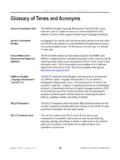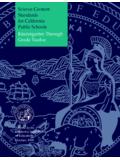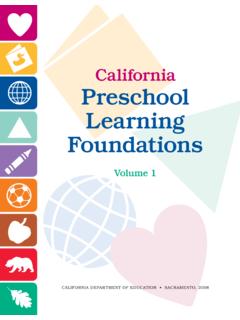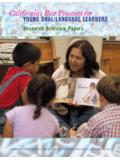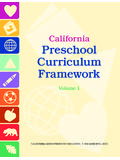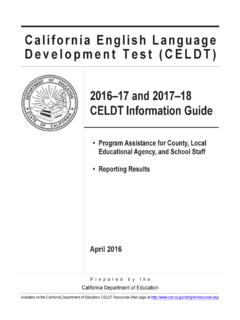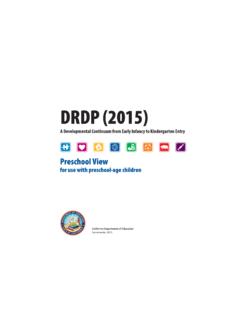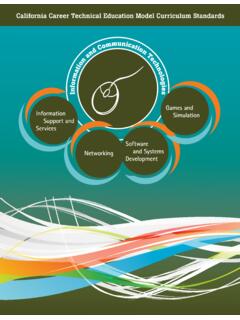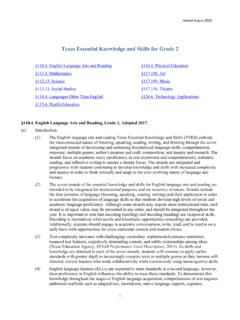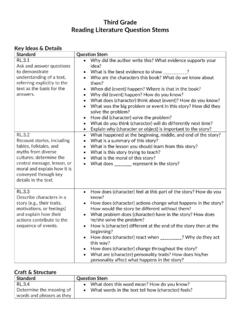Transcription of 2013 Math Framework, Grade 2 - Curriculum Frameworks (CA ...
1 Grade -Two Chapter of theMathematics Framework for California Public Schools:Kindergarten Through Grade TwelveAdopted by the California State Board of Education, November 2013 Published by the California Department of EducationSacramento, 2015871K32546 Grade TwoIn Grade two, students further build a mathematical foundation that is critical to learning higher math-ematics. In previous grades, students developed a foundation for understanding place value, including grouping in tens and ones. They built understanding of whole numbers to 120 and developed strategies to add, subtract, and compare numbers. They solved addition and subtraction word problems within 20 and developed fluency with these operations within 10.
2 Students also worked with non-standard measurement and reasoned about attributes of geometric shapes (adapted from Charles A. Dana Center 2012).Critical Areas of InstructionIn Grade two, instructional time should focus on four crit-ical areas: (1) extending understanding of base-ten nota-tion; (2) building fluency with addition and subtraction; (3) using standard units of measure; and (4) describing and analyzing shapes (National Governors Association Center for Best Practices, Council of Chief State School Officers [NGA/CCSSO] 2010i). Students also work toward fluency with addition and subtraction within 20 using mental strategies and within 100 using strategies based on place value, properties of operations, and the relationship between addition and subtraction.
3 They know from memory all sums of two one-digit numbers. California Mathematics Framework Grade Two 119 Standards for Mathematical ContentThe Standards for Mathematical Content emphasize key content, skills, and practices at each Grade level and support three major principles:l Focus Instruction is focused on Grade -level Coherence Instruction should be attentive to learning across grades and to linking major topics within Rigor Instruction should develop conceptual understanding, procedural skill and fluency, and examples of focus, coherence, and rigor are indicated throughout the standards do not give equal emphasis to all content for a particular Grade level. Cluster headings can be viewed as the most effective way to communicate the focus and coherence of the standards.
4 Some clusters of standards require a greater instructional emphasis than others based on the depth of the ideas, the time needed to master those clusters, and their importance to future mathematics or the later demands of preparing for college and careers. Table 2-1 highlights the content emphases at the cluster level for the Grade -two standards. The bulk of instructional time should be given to Major clusters and the standards within them, which are indicated throughout the text by a triangle symbol ( ). However, stan-dards in the Additional/Supporting clusters should not be neglected; to do so would result in gaps in students learning, including skills and understandings they may need in later grades.
5 Instruction should reinforce topics in major clusters by using topics in the addition-al/supporting clusters and including problems and activities that support natural connec-tions between and administrators alike should note that the standards are not topics to be checked off after being covered in isolated units of instruction; rather, they provide content to be developed throughout the school year through rich instructional experiences present-ed in a coherent manner (adapted from Partnership for Assessment of Readiness for College and Careers [PARCC] 2012).120 Grade Two California Mathematics FrameworkTable 2-1. Grade Two Cluster-Level EmphasesOperations and Algebraic Thinking Clusters Represent and solve problems involving addition and subtraction.
6 (2 .OA .1 ) Add and subtract within 20. ( )Additional/Supporting Clusters Work with equal groups of objects to gain foundations for multiplication. ( 4)Number and Operations in Base Ten Clusters Understand place value. ( 4 ) Use place-value understanding and properties of operations to add and subtract. ( 9 )Measurement and Data Clusters Measure and estimate lengths in standard units. ( 4 ) Relate addition and subtraction to length. ( 6 )Additional/Supporting Clusters Work with time and money. ( 8) Represent and interpret data. ( 10)Geometry Clusters Reason with shapes and their attributes.
7 (2 .G .1 3)Explanations of Major and Additional/Supporting Cluster-Level EmphasesMajor Clusters ( ) Areas of intensive focus where students need fluent understanding and application of the core concepts. These clusters require greater emphasis than others based on the depth of the ideas, the time needed to master them, and their importance to future mathematics or the demands of college and career Clusters Expose students to other subjects; may not connect tightly or explicitly to the major work of the Clusters Designed to support and strengthen areas of major of caution: Neglecting material, whether it is found in the major or additional/supporting clusters, will leave gaps in students skills and understanding and will leave students unprepared for the challenges they face in later from Achieve the Core 2012.
8 California Mathematics Framework Grade Two 121 Connecting Mathematical Practices and ContentThe Standards for Mathematical Practice (MP) are developed throughout each Grade and, together with the content standards, prescribe that students experience mathematics as a rigorous, coherent, useful, and logical subject. The MP standards represent a picture of what it looks like for students to under-stand and do mathematics in the classroom and should be integrated into every mathematics lesson for all the description of the MP standards remains the same at all Grade levels, the way these standards look as students engage with and master new and more advanced mathematical ideas does change. Table 2-2 presents examples of how the MP standards may be integrated into tasks appropriate for students in Grade two.
9 (Refer to the Overview of the Standards Chapters for a description of the MP standards.)Table 2-2. Standards for Mathematical Practice Explanation and Examples for Grade TwoStandards for Mathematical Explanation and ExamplesPracticeM Grade two, students realize that doing mathematics involves reasoning about and solving problems. Students explain to themselves the meaning of a problem and look for ways to Make sense of solve it. They may use concrete objects or pictures to help them conceptualize and solve problems and problems. They may check their thinking by asking themselves, Does this make sense? persevere in They make conjectures about the solution and plan out a problem-solving P. 2 Younger students recognize that a number represents a specific quantity.
10 They connect the quantity to written symbols. Quantitative reasoning entails creating a representation of a Reason problem while attending to the meanings of the quantities. abstractly and represent situations by decontextualizing tasks into numbers and symbols. For example, a task may be presented as follows: There are 25 children in the cafeteria, and they are joined by 17 more children. How many students are in the cafeteria? Students translate the situation into an equation (such as 25 + 17 = ) and then solve the problem. Students also contextualize situations during the problem-solving process. To reinforce stu-dents reasoning and understanding, teachers might ask, How do you know? or What is the relationship of the quantities?

